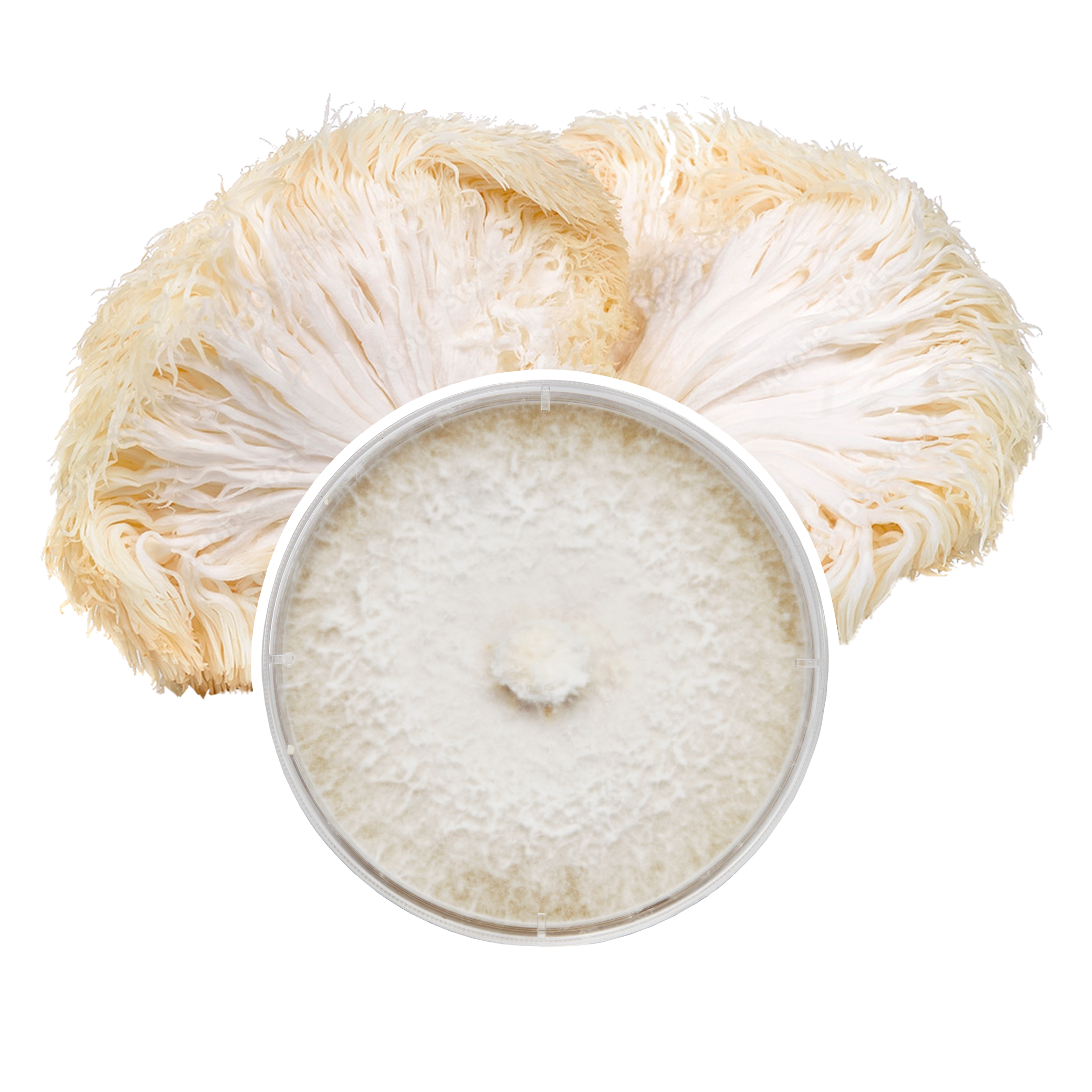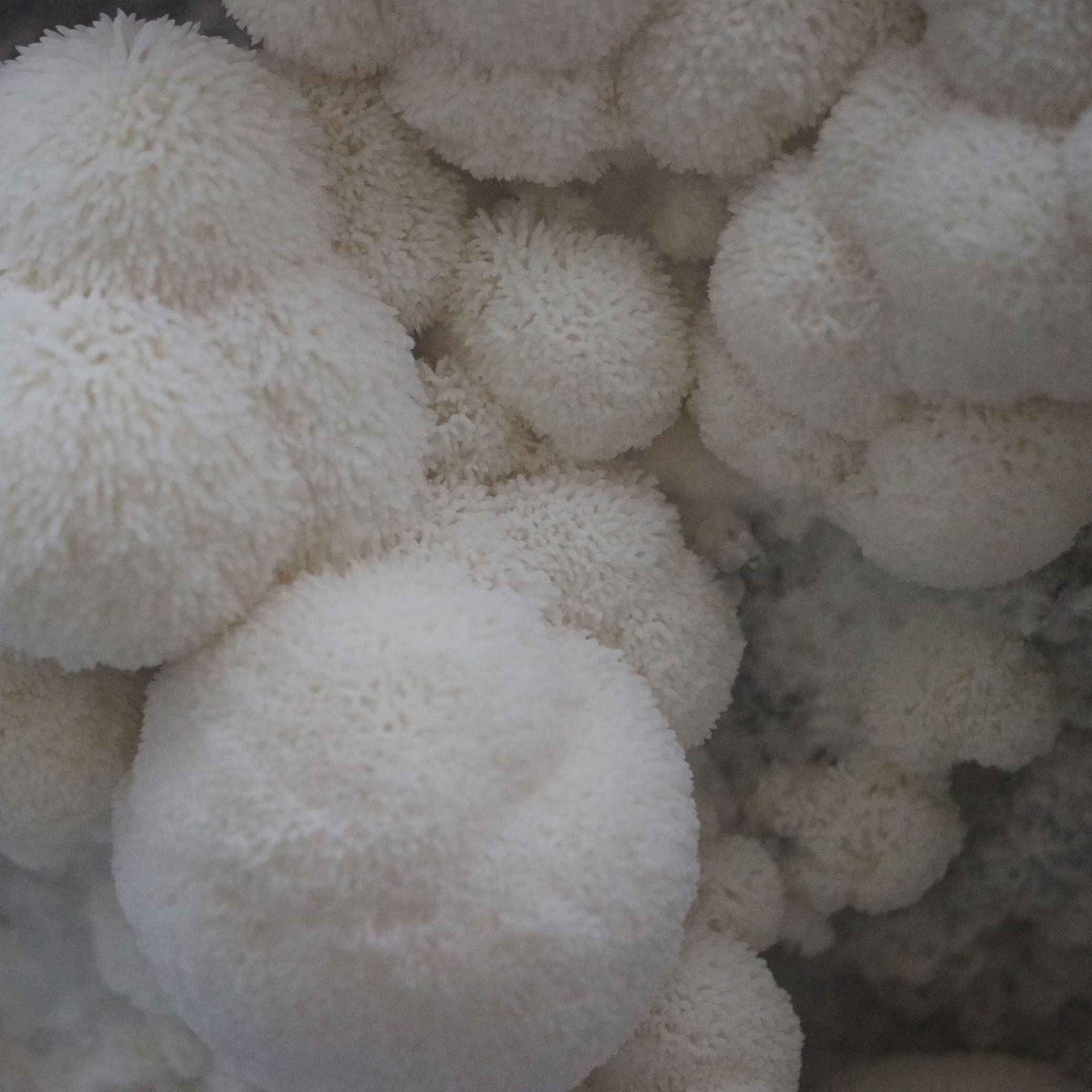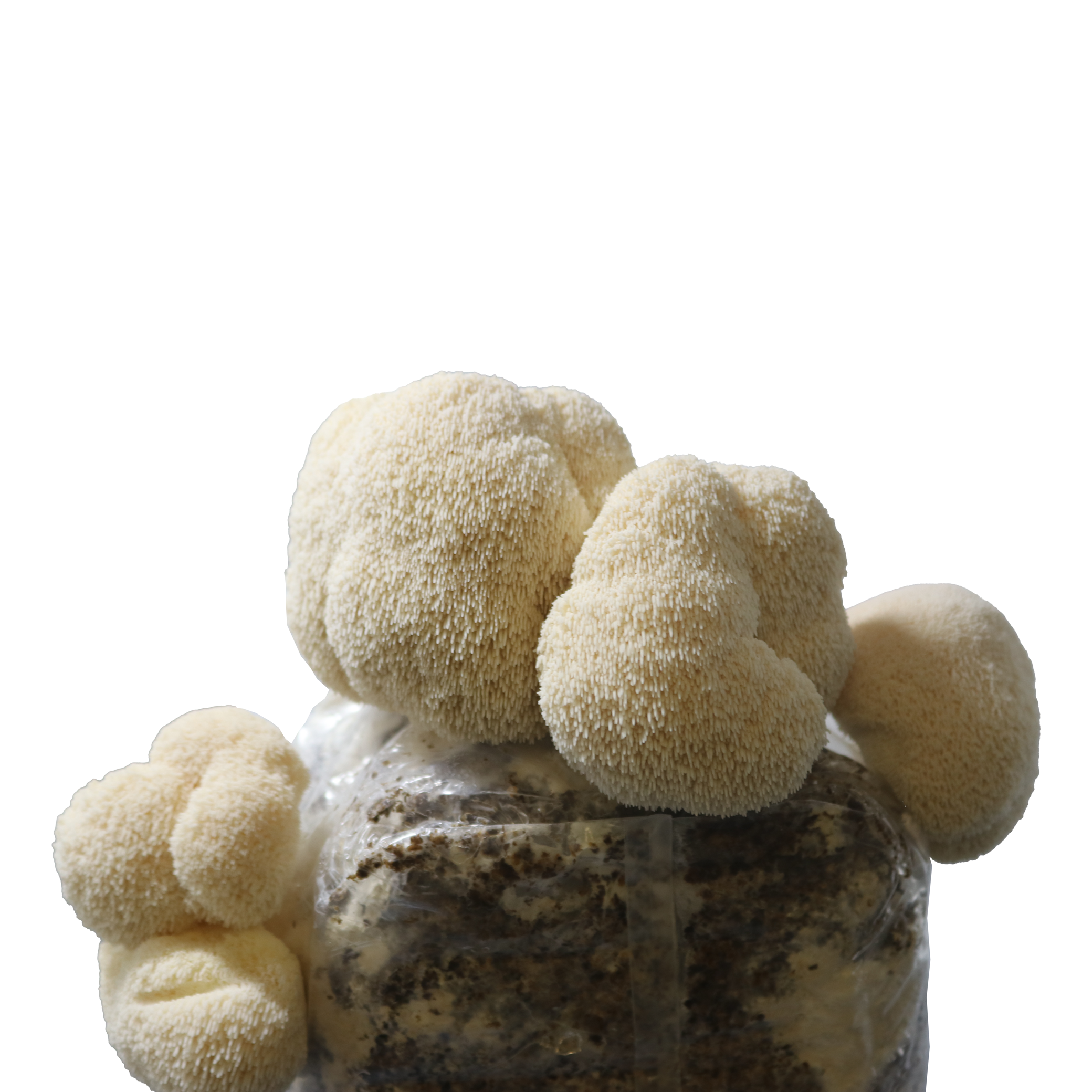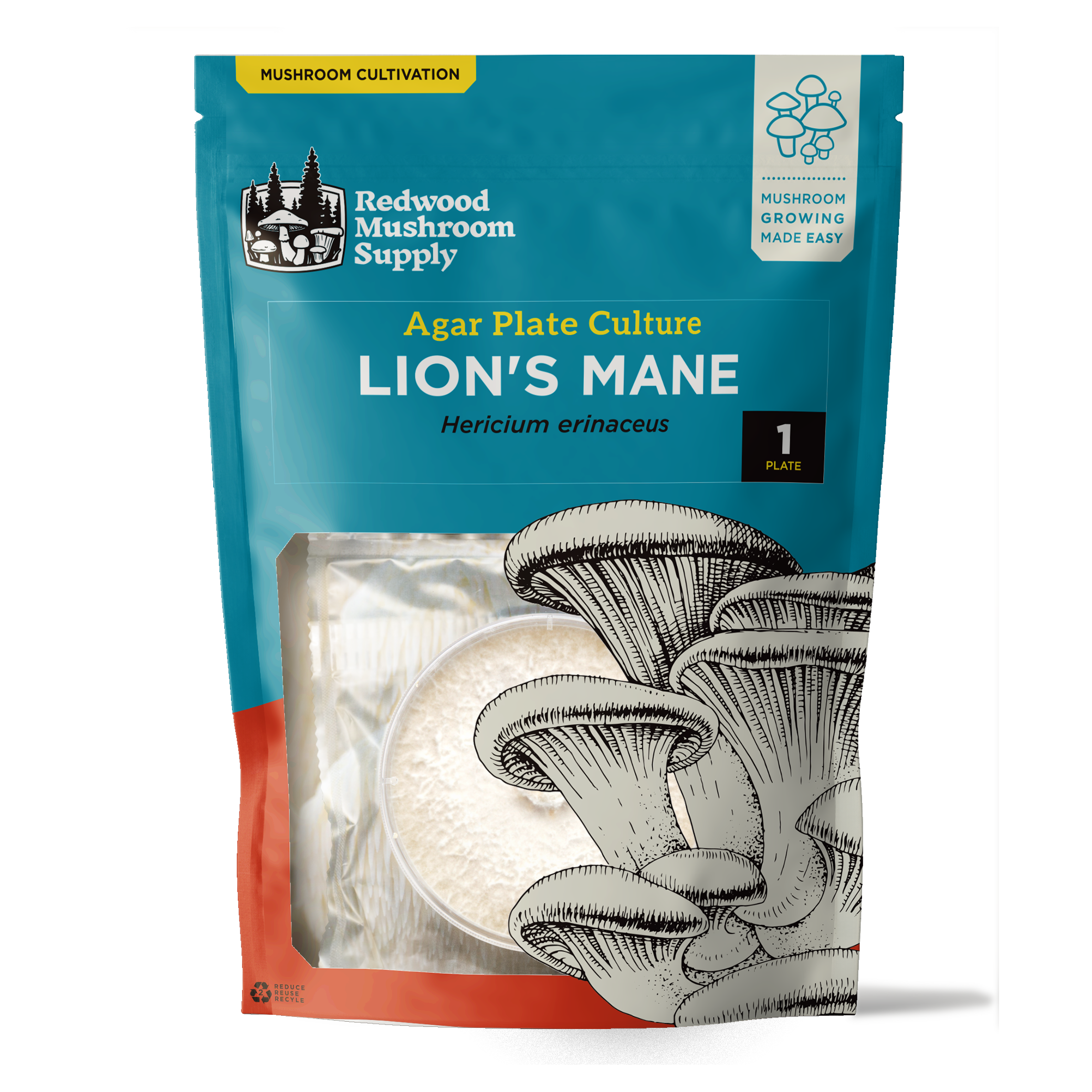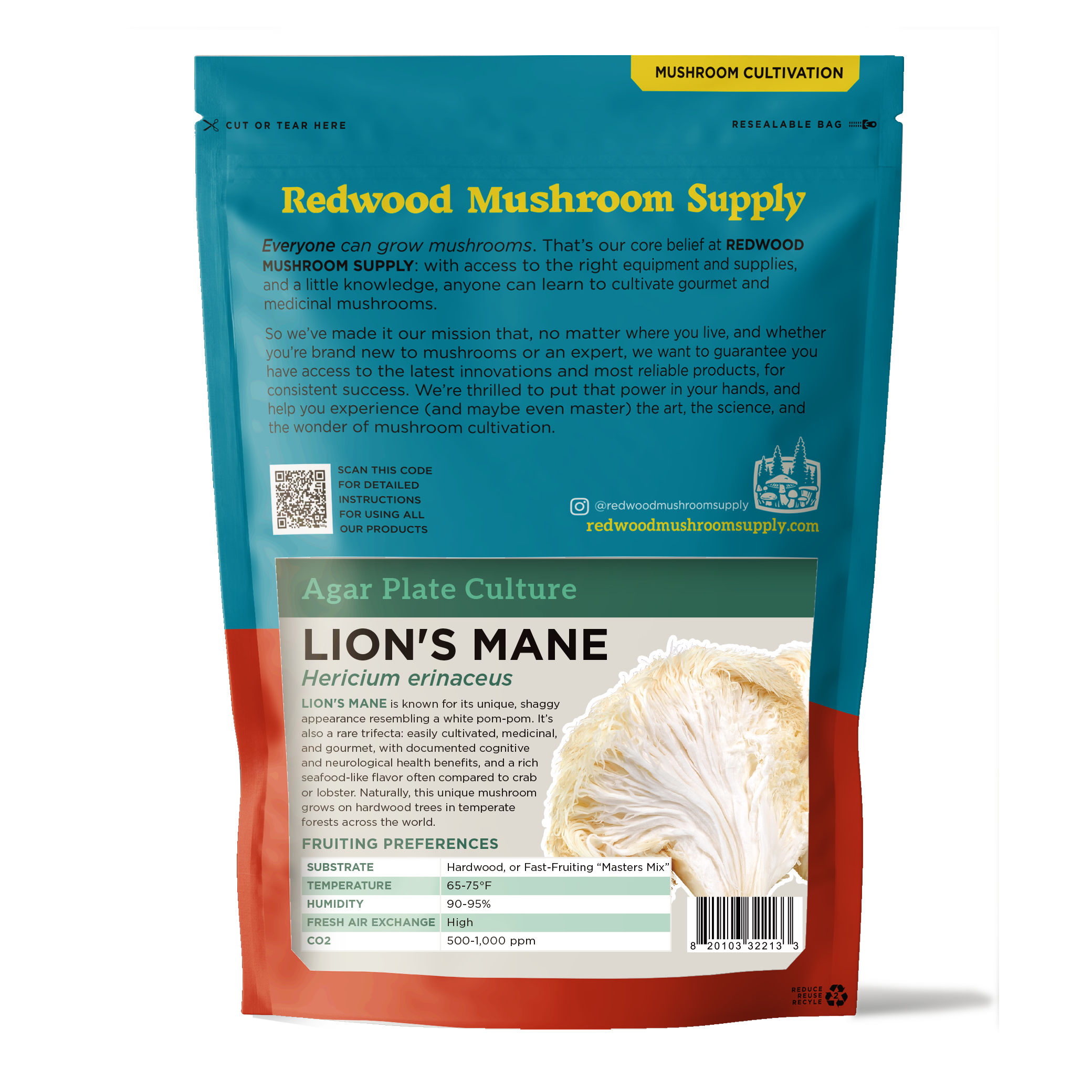Features
Lion’s Mane (Hericium erinaceus)
- Lion’s Mane plate culture
- 100 mm x 15 mm petri dish with malt extract agar
- Easy to grow, fast-fruiting strain
- Produces multiple flushes of voluminous, white fruit bodies
- Hardy commercial strain excellent for side-fruiting
- Rare trifecta: easily cultivated, valued for health benefits, excellent flavor/texture
- Prefers Fast-Fruiting/Master’s Mix or other hardwood substrates
Redwood Mushroom Supply Process
- Early generation cultures ensure vitality
- Plates made with high-quality, lab-grade inputs
- Sterilization verified using chemical sterilization indicators
- Each batch tracked and quality-controlled for contamination-free cultures
- Packaged in a clean-air environment
- Plates are individually wrapped and sealed in breathable filter bags
- All strains grown in-house to ensure consistent quality
Lion’s Mane Mushroom Plate Culture
Your Price:
Lion’s Mane mushrooms are recognized for their unique pom-pom-like fruit bodies and notable medicinal value. This hardy, commercially viable strain grows well on sterilized hardwood substrates, forming dense clusters. It is a fast-fruiter and heavy-yielder, suitable for all skill levels. Lion’s Mane cultivation with plate culture requires a still-air box or laminar flow hood for best results, making it ideal for growers looking to refine and improve their skills.
Lion’s Mane (Hericium erinaceus)
Lion’s Mane is known for its unique, shaggy appearance resembling a white pom-pom. It’s also a rare trifecta: easily cultivated and sought both for health and gourmet uses, with documented cognitive and neurological health benefits and a rich seafood-like flavor often compared to crab or lobster. Naturally, this unique mushroom grows on hardwood trees in temperate forests across the world.
This Lion’s Mane strain is an excellent example of the potential of this mushroom, with high yields and large clusters when grown on fast-fruiting mixes. It’s a hardy and commercially viable strain that performs very well with moderate to high airflow and high humidity to support the growth of large fruit clusters.
Lion’s Mane fruit bodies can be cooked and consumed as a meat substitute, or dried and powdered for use as a health supplement, making it a versatile mushroom that anyone can grow at home!
About Redwood Mushroom Supply (RMS) Cultures
All RMS Plate Cultures are prepared from early-generation slants from their culture bank. These robust cultures are used to inoculate agar plates prepared with high-quality inputs, ensuring you receive vigorous and reliable cultures.
Each culture is hand-packaged in a clean-air laboratory environment. Their cultures are batch-tracked and undergo thorough quality control to ensure robust growth and contamination-free conditions.
NOTE: The growing instructions and predicted yields in the details and technical specifications are based on our observations and may vary based on your growing method and environment.
Technical Specifications
| Length Inches | |
|---|---|
| Width Inches | |
| Height Inches | |
| Product Weight | |
| Case Quantity | |
| Case Dimensions (L"xW"xH") | |
| Case Weight lbs |
| Materials | ||
|---|---|---|
| Thickness | ||
| Tensil Strength | ||
| Climate Suitability | ||
| Transmission Rate | ||
| Diffusion Rate | ||
| Custom Size Option | ||
| Substrate |
Hardwood, Fast-Fruiting/Master's Mix |
|
| Temperature |
65-75°F |
|
| Humidity |
90-95% |
|
| Fresh Air Exchange |
High |
|
| CO2 Tolerance |
500-1,000 ppm |
|
| Fruiting Method |
Bags in growth chamber |
|
| Bag Weight | ||
| Best Use | ||
| Category | Live Cultures |
These plate cultures provide a robust starting point for mushroom cultivation. For optimal results, we recommend transferring agar from the colonized petri dish to sterilized grain bags or jars. Once fully colonized, the grain spawn can be used to inoculate wood-based substrate at a 5-10% grain-to-substrate ratio. Perform transfers using a still-air box or laminar flow hood to increase the success of your culture expansion.
Plate cultures can also be used to create liquid cultures for bulk inoculation and can be made into additional plates or slants for storage and future use.
Storage
For best results, store your plate culture in the refrigerator until ready to use. Ensure the plate is fully sealed before storing. If you plan to use the culture within 1-3 weeks, refrigeration is not necessary. When refrigerated, plate cultures can remain viable for up to 6 months. Do not freeze, as this can damage the mycelium. Keep out of direct sunlight and avoid exposure to heat.
Plate Culture Use Instructions
EQUIPMENT CHECKLIST
- RMS Plate Culture
- Sterilized grain
- Disposable gloves
- 70% isopropyl alcohol in a spray bottle
- Scalpel
- Tool sterilizer or open flame for sterilizing tools
- Sealing film
- Recommended: Laminar flow hood or still-air box
INSTRUCTIONS
1. PREPARE YOUR ENVIRONMENT
- Wash your hands and put on a pair of disposable gloves.
- Disinfect your workspace and gloves with 70% isopropyl alcohol.
- For best results, use a laminar flow hood or a still-air box when working with open cultures.
- Note: Maintaining a clean environment is essential for successful inoculation and optimal culture growth.
2. DISINFECT MATERIALS
- Remove plate culture from the filter bag.
- Spray the exterior of the sealed plate culture and items to be inoculated with 70% isopropyl alcohol.
- Allow alcohol to evaporate completely before inoculating.
- Note: Always use sterile tools when working with cultures. Use a tool sterilizer to sterilize tools between transfers. If using an open flame to sterilize your tools, exercise extreme caution while using isopropyl alcohol in the same area.
3. INOCULATE
- Remove the sealing film and petri dish lid from plate culture.
- Using sterile tools, carefully cut a 1 cm × 1 cm wedge of agar from the plate culture and transfer it to sterile grain, agar, or liquid culture. Replace petri dish lid when complete and seal your inoculated bag, plate or jar.
- Now is a great chance to transfer your culture to additional sterile agar plates to create backup cultures.
4. COLONIZE
- Place the inoculated bag, plate, or jar in a 70-75° F environment to encourage mycelial growth.
Details
Lion’s Mane (Hericium erinaceus)
Lion’s Mane is known for its unique, shaggy appearance resembling a white pom-pom. It’s also a rare trifecta: easily cultivated and sought both for health and gourmet uses, with documented cognitive and neurological health benefits and a rich seafood-like flavor often compared to crab or lobster. Naturally, this unique mushroom grows on hardwood trees in temperate forests across the world.
This Lion’s Mane strain is an excellent example of the potential of this mushroom, with high yields and large clusters when grown on fast-fruiting mixes. It’s a hardy and commercially viable strain that performs very well with moderate to high airflow and high humidity to support the growth of large fruit clusters.
Lion’s Mane fruit bodies can be cooked and consumed as a meat substitute, or dried and powdered for use as a health supplement, making it a versatile mushroom that anyone can grow at home!
About Redwood Mushroom Supply (RMS) Cultures
All RMS Plate Cultures are prepared from early-generation slants from their culture bank. These robust cultures are used to inoculate agar plates prepared with high-quality inputs, ensuring you receive vigorous and reliable cultures.
Each culture is hand-packaged in a clean-air laboratory environment. Their cultures are batch-tracked and undergo thorough quality control to ensure robust growth and contamination-free conditions.
NOTE: The growing instructions and predicted yields in the details and technical specifications are based on our observations and may vary based on your growing method and environment.
Usage
These plate cultures provide a robust starting point for mushroom cultivation. For optimal results, we recommend transferring agar from the colonized petri dish to sterilized grain bags or jars. Once fully colonized, the grain spawn can be used to inoculate wood-based substrate at a 5-10% grain-to-substrate ratio. Perform transfers using a still-air box or laminar flow hood to increase the success of your culture expansion.
Plate cultures can also be used to create liquid cultures for bulk inoculation and can be made into additional plates or slants for storage and future use.
Storage
For best results, store your plate culture in the refrigerator until ready to use. Ensure the plate is fully sealed before storing. If you plan to use the culture within 1-3 weeks, refrigeration is not necessary. When refrigerated, plate cultures can remain viable for up to 6 months. Do not freeze, as this can damage the mycelium. Keep out of direct sunlight and avoid exposure to heat.
Plate Culture Use Instructions
EQUIPMENT CHECKLIST
- RMS Plate Culture
- Sterilized grain
- Disposable gloves
- 70% isopropyl alcohol in a spray bottle
- Scalpel
- Tool sterilizer or open flame for sterilizing tools
- Sealing film
- Recommended: Laminar flow hood or still-air box
INSTRUCTIONS
1. PREPARE YOUR ENVIRONMENT
- Wash your hands and put on a pair of disposable gloves.
- Disinfect your workspace and gloves with 70% isopropyl alcohol.
- For best results, use a laminar flow hood or a still-air box when working with open cultures.
- Note: Maintaining a clean environment is essential for successful inoculation and optimal culture growth.
2. DISINFECT MATERIALS
- Remove plate culture from the filter bag.
- Spray the exterior of the sealed plate culture and items to be inoculated with 70% isopropyl alcohol.
- Allow alcohol to evaporate completely before inoculating.
- Note: Always use sterile tools when working with cultures. Use a tool sterilizer to sterilize tools between transfers. If using an open flame to sterilize your tools, exercise extreme caution while using isopropyl alcohol in the same area.
3. INOCULATE
- Remove the sealing film and petri dish lid from plate culture.
- Using sterile tools, carefully cut a 1 cm × 1 cm wedge of agar from the plate culture and transfer it to sterile grain, agar, or liquid culture. Replace petri dish lid when complete and seal your inoculated bag, plate or jar.
- Now is a great chance to transfer your culture to additional sterile agar plates to create backup cultures.
4. COLONIZE
- Place the inoculated bag, plate, or jar in a 70-75° F environment to encourage mycelial growth.
